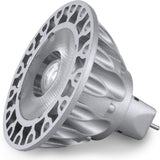MR16 Luminous Intensity - How Does LED Compare to Halogen?
Posted by Dave on for ProLampSales

We've written here before about one of the toughest problems for manufacturers of LED replacement lamps: achieving light intensity comparable to halogen in the MR16 form factor - particularly for narrow beam distribution.
The initial blog post was written in 2014, then updated in late 2016. The update concluded by stating that new breakthroughs in GaN on GaN technology had allowed the manufacturing of single point source LED MR16's – an important step toward replicating halogen display lighting particularly at narrow beam angles in a small format lamp like the MR16. While some progress had been made in moving closer to the center-beam candlepower values of halogen MR16 spot (10° - 15°), LED still lagged considerably behind on that metric making it difficult to recommend direct replacement of halogen MR16 spots with LED.
For many narrow beam spot and accent lighting applications, luminous intensity is a significant attribute. The Illumination Engineering Society of North America (IESNA) defines center-beam candlepower as "the luminous intensity along the centerline of a directional light source." The values for luminous intensity are expressed as CBCP or CD.
Two more years have passed and with new generation LED bulbs from manufacturers continuing to be released at least once a year, it seemed a good time to check back on this issue.
LED / Halogen MR16 Center-Beam Candlepower Comparison
For this analysis we created a simple table of both LED and halogen MR16 bulbs and consulted manufacturer specification sheets for the values. In all cases we selected bulbs designed for commercial grade applications. We looked at both spot (10° to 15°) and narrow flood (25°) distributions commonly used in display and accent lighting where "luminous intensity" is a key attribute. Units for luminous intensity, used interchangeably, are "candelas" cd and "center-beam candlepower", CBCP.
What these values clearly show is that for narrow beam spot distributions (10° to 15°) there is a significantly lower luminous intensity than with comparable halogen. Generally the same holds true for narrow beam flood (25°) MR16 lamps, although luminous intensity is probably less of a factor in these applications.
Interestingly, this comparison of luminous intensity also demonstrates (in a small sample size) significant variance in luminous intensity even within the same light source.
While the numbers speak for themselves, values from a specification sheet do not tell the whole story when comparing directional light sources. As stated in a technology paper from SORAA, "When directional lamps are specified, one often looks at classic metrics: beam angle, center-beam candlepower, average chromaticity... yet when we visually assess lamps, we are often surprised at the huge variations in how the beam 'feels' - even for nominally identical sources."
The subjective nature of the quality of light must always be considered, which may account for the fact that in some applications a 7300 CBCP LED lamp can replace a 15,000 CBCP lamp of comparable color quality and still be acceptable.
However, in most cases where highly directional, narrow beam and spot distribution is required, an MR16 LED lamp replacement will yield (both measurable and perceptible) lower intensity light compared to the halogen it is replacing. This is true even for the best LED MR16s on the market.
Importantly, at wider beam angles, high quality LED MR16s designed for commercial applications (from SORAA, Philips, Ushio, Sylvania, and others) equal or exceed the performance of halogen.
Conclusion
The bottom line conclusion: in late 2018, when considering the replacement of halogen MR16 spots with LED, the most important step is to purchase a few lamps from different manufacturers, install them on location and visually compare the illumination, side by side with the halogen lamps.
In addition, given the differences in manufacturer reported luminous intensity within LED and halogen categories, it is also apparent that installing test lamps to visually assess the lighting is important in either case - buying LED or halogen.
Featured Products (View All)
0 Comments




